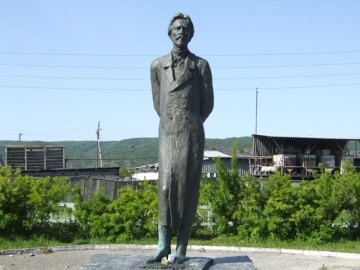Following Chekhov to ‘Hell’
Travel Stories: On Sakhalin Island, Robert Reid communes with the world's first "Gulag tourist"
11.04.09 | 10:41 AM ET
 Photo of Chekhov statue by Robert Reid
Photo of Chekhov statue by Robert ReidIn 1890, 30-year-old Anton Chekhov was already a Pushkin Prize winner with hit plays swooning Moscow’s elite when he pulled a Dave Chappelle. He turned his back on fame and packed for a penal colony north of Japan on Sakhalin Island, a place he’d later call “hell.” Unlike so many other Russian writers, he wasn’t going in chains, but as a tourist.
Traveling the same year Joseph Conrad’s heart darkened on the Congo (and a year before the Trans-Siberian Railway construction began), Chekhov went the hard way—overland, across 6,000 miles of muddy roads and rivers, an epic three months one way. While living on the island, he woke to the clanking sounds of prisoners in chains, witnessed bare-backed lashings, and noted how wives and daughters lived off prostitution. During a visit to Dooay Prison, he became the world’s first “Gulag tourist,” staying in a house where “millions and millions of insects” coated the walls and ceilings, “moving as if in wind.” Most prisoners’ quarters were worse. The island’s effect was “nihilistic in the fullest sense of the word,” he wrote in his only non-fiction work, the sobering Sakhalin Island. He had hoped it might lead to prison reforms. It did not.
While traveling in the Russian Far East last summer, I decided to feed the inner Russian lit freak rooted in my fidgety college years by visiting a few spots along this “Chekhov trail” to see how the locals remembered the legendary drop-by. Or if one could find a little cheer in a place so linked with terror. Because much of his route was way off today’s Trans-Siberian, and frequently dreary, I began where the lonely playwright had been happiest, Blagoveshchensk (roughly “good news”) on the Chinese border, six time zones east of Moscow.
Today the city of over 200,000 is surprisingly lively, with a mix of Tsar-era mansions, Soviet housing and glitzy casinos. After dumping my bags off at a renovated communist-era hotel with a giant rat mural in the lobby, I walked along the Amur River promenade passing beer-sipping Russian men in muscle shirts and looking over to Heihe, the booming Chinese border town where children could be seen splashing in water. Nearby I found the gorgeous 19th-century red-and-white river port (now a geological institute). A lady in a wide navy blue dress quickly waddled out from her administratsi desk to bar my entrance. I asked about the day when Chekhov came through the building. “I know nothing of it,” she snapped. “We study rocks, not writers.”
My visit happened to be timed with the suspension, after 48 consecutive years, of the ferry to Khabarovsk, so, alas, I could only follow the next leg of the century-old trip, loosely, by train. Chekhov had professed his “love” for the scenery here (and a Japanese geisha he met). My train to Komsomolsk (nearly 40 hours, with a change in Khabarovsk) clanked past wide fields and scattered taiga forest. I didn’t feel any particular attraction. Nor did I when a chubby bleach-blonde Russian hooker working the carriage dropped by. My meaty cabin mate disappeared with her and I tried to sleep.
At the mouth of the north-flowing Amur, remote Nikolaevsk was already past its prime in 1890, when Chekhov imagined it as a Texas or Patagonia. Time hasn’t helped much. No roads or rails yet reach it. I arrived by hydrofoil (a pleasant 12-hour trip from Komsomolsk) and rolled my suitcase along cracked sidewalks past belching smokestacks to the city’s lone hotel, whose staff insisted a scrawny 20-year-old attendant named Sergei follow me everywhere. “For safety,” he sighed. I wasn’t sure if I could refuse, so together we searched out a tiny museum, where we found no mention of Chekhov’s restless night here. But Sergei helpfully pointed to a dismantled bust in the corner. “This is Stalin. Do you know him?”
Chekhov spent most of his time on Sakhalin Island at Aleksandrovsk—or the “Paris of the Sakhalin” per one naïve local official. Chekhov’s first impression of it, arriving by boat, was a “fearful picture, crudely cut out of darkness, silhouettes of mountains, smoke, flames and sparks from the fires.” Soon he’d vow never to return.
No ferry goes there anymore, so I flew into Yuzhno-Sakhalinsk, a busy oil town in the south of the island, and took an overnight train midway up the island to Tymovskoe, where a couple daily buses reach Aleksandrovsk. Waiting at a nearby bus stop, I found myself facing a half-circle of hungover, fierce-looking young men in tracksuits. I might have run, but they were in tears. One with upturned nostrils and a puss-filled eye was leaving the rest.